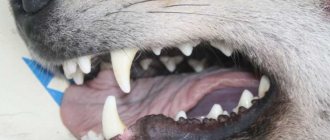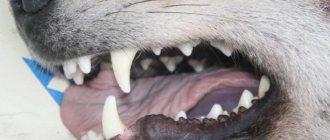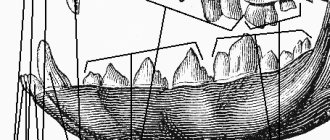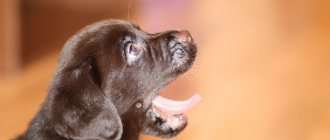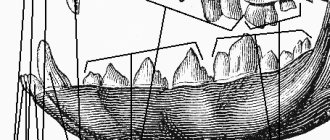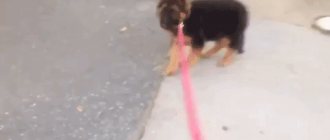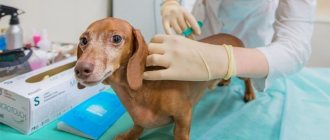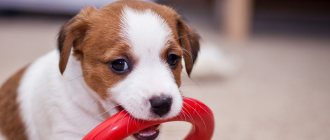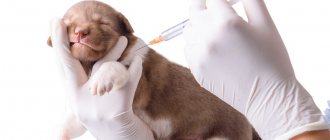Just like in children, dogs change their milk teeth to permanent teeth, with only one difference - by the age of one year the puppy turns into an adult dog. Most physiological processes, including the change of teeth in dogs, proceed at an accelerated rate.
Dog puppies are born with no teeth in the mouth - with bare gums - and by adulthood they have 42 permanent teeth.
During their lifetime, dogs have two sets of teeth - milk and permanent. Moreover, regardless of the dog’s breed, the replacement of milk teeth with permanent ones occurs in the same sequence; the only difference is in the timing of the change of teeth. There is such a pattern - in dogs of large breeds, unlike dogs of small breeds, the change of milk teeth to permanent teeth occurs faster.
Milk teeth in puppies
Puppies are born with missing teeth. They feed exclusively on mother's milk. The first milk teeth in puppies begin to appear 20-30 days after birth.
At the same time, in dogs of dwarf and decorative breeds, the first milk teeth appear at 1.5 months of age. With proper jaw development, puppies should have 28 primary teeth (14 teeth on the lower jaw and 14 teeth on the upper jaw). Of the milk teeth there are 4 canines, 12 incisors and 12 molars. The canines begin to appear first, then the incisors, and lastly the molars.
Teething order
The first teeth to appear are the baby teeth. This occurs on the 20-30th day from birth. Dogs are predators and first of all they grow 6 incisors on each jaw, 12 in total. Canines - 2 canines on each jaw. The last to erupt are the 16 premolars. The total number of baby teeth is 32 in a puppy aged 2-3 months (in some breeds – 28).
Large breeds
In large dog breeds, this process is fairly quick and painless. The huge mouth provides space for proper eruption and further development of the dental arch. Problems occur when the animal is exhausted, has suffered a deep maxillofacial injury, breeding control and breed line are not maintained, or close mixing of blood has occurred.
The process is similar to large breeds, but the closer to the lower limit of medium-sized dogs, the greater the likelihood of pathologies (delayed shifts, missing teeth, etc.).
Small breeds
This group of dogs is most susceptible to dental risks. The process itself is very slow and delayed compared to other large dogs. Breeds with flattened faces often suffer from missing teeth. Access to the oral cavity is limited and control is difficult.
Permanent teeth in dogs
When the puppy reaches the age of 4-6 months, the dog’s milk teeth, like those of children, begin to change to permanent teeth. The replacement of baby teeth with permanent ones usually lasts two months and depends on the breed of the dog. At the same time, the number of permanent teeth that appear exceeds the number of milk teeth; the dog has 42 of them. All permanent teeth are divided equally into the upper and lower jaws, with the exception of molars, of which there are two more in the lower jaw.
The change of teeth in dogs is due to the fact that the rather long root of a baby tooth gradually dissolves, becomes weak and is pushed out by a strong, growing permanent tooth.
The first of the dog's permanent teeth to appear is the incisors, then at five months the molars (molars and premolars) appear; the last of the dog's permanent teeth to appear are the canines, first on the lower and then on the upper jaw. The complete replacement of milk teeth in dogs should be completed by the first year of life (up to 9 months in large breeds and 10-11 months in small breeds of dogs).
By this time, the dog does not have a single baby tooth. Usually, the replacement of baby teeth with permanent teeth in dogs is painless and easy.
Sometimes, especially in small and short-faced breeds of dogs, a permanent tooth grows next to the baby tooth. Experts explain this phenomenon by the fact that the dog has poorly developed chewing muscles, especially when puppies eat soft food, as well as a decrease in the size of the gums.
In dogs of large breeds - Great Danes, Rottweilers, Mastiffs - there are additional incisors. Experts consider this a variant of the norm.
Any disruption in the replacement of baby teeth with permanent teeth negatively affects the formation of the upper and lower jaws and the dog’s bite. Therefore, all baby teeth that fall out at the wrong time must be removed at a veterinary clinic. During the removal of milk teeth, space for permanent teeth is made in a timely manner, as a result the dog will develop a correct bite.
In order for the process of changing teeth to proceed correctly, the puppy needs proper feeding and vitamins (feeding puppies, vitamins for dogs).
Why do you need to know when dogs change their milk teeth to permanent ones?
Experts have proven that the process of changing teeth in dogs affects the animal’s immune system, which at a given period of time is experiencing disruptions in the dog’s body. The dog becomes less resistant to various adverse environmental factors, infectious and parasitic diseases. At this time, veterinary experts do not recommend vaccinating dogs against certain infectious diseases common in the region of residence. These repeated vaccinations are postponed to the time when the dog has completed the replacement of milk teeth with permanent teeth. In order to reduce the risk of the puppy contracting one or another infectious disease, dog owners must complete all vaccinations before changing teeth.
Signs of a healthy grin in a dog
By the end of the first year of life, dogs develop a strong, healthy and permanent grin of 42 teeth. A deviation in the number of teeth, both smaller and larger, indicates a violation of the puppy’s intrauterine development or is a consequence of mutations at the genetic level.
The color of the tooth enamel changes from white to slightly yellow during the dog’s life.
The angle of growth of the teeth and the contact of the upper and lower jaws (bite) are different in different breeds of dogs. Deviation from the normal arrangement of teeth among specialists has its own name.
As dogs age, tooth crowns wear down and canines wear down. If the dog has a normal bite, tooth wear occurs evenly and does not affect food intake.
How does changing teeth affect a puppy's health?
Teething in puppies is usually painless for them. Puppies, like a child, when he is teething, in order to relieve the itching in his gums, drag various toys into the oral cavity or gnaw everything around him. To relieve itching, pet stores sell special toys or tendon bones.
In some cases, when the first teeth appear, there may be a slight increase in body temperature, lethargy, decreased appetite (loss of appetite in the dog) and, as an exception, diarrhea.
Types of bite in dogs
Not only its exterior, but also the animal’s health depends on the position in which the dog’s upper and lower jaws are in relation to each other. As a result of an incorrect bite, a dog can develop diseases of the digestive system, respiratory system, and sometimes the heart.
Main types of bite:
Normal or scissor.
In the process of evolution, wild dogs were forced to hunt other animals to feed themselves, as a result of which the structure of the jaws of dogs was designed to grab and hold prey. Therefore, for most dog breeds this bite is considered normal. With this type of jaw bite, the upper and lower jaws are equally developed. The front surface of the lower incisors is tightly adjacent to the back surface of the upper ones, the dog’s canines converge in a “lock”, the lower incisors rest against the base of the upper incisors. This type of bite is considered the norm for dogs - German and Caucasian, Doberman Pinschers, Pinschers, Terriers. Dogs with this type of malocclusion have less wear on their teeth, and owners of these breeds are less likely to go to the veterinary clinic with dental problems.
Pincer or level bite.
The position of the jaws in a straight bite is considered unacceptable for most dog breeds. Experts still classify this type of bite as a not too serious defect. With a pincer bite, the dog's upper and lower incisors are located on the same line and rest against each other, as a result of which the dog's teeth quickly wear down. This jaw position is considered unacceptable for most dog breeds. However, a pincer bite is still considered a not too serious defect. In this case, the dog’s lower and upper incisors are located on the same line and rest against each other, because of this they grind down very quickly. At the same time, a direct bite in dogs usually does not have a negative effect on the canines and molars. This type of bite in dogs can be either congenital or acquired. This type of bite in a puppy can be formed by the owners of the animal themselves as a result of too active games of tugging with the help of toys.
Underbite.
With an underbite, the dog's lower jaw is underdeveloped. Because of this, the dog has free space between the incisors. The lower canines are loosely adjacent to the edges of the upper jaw. An underbite in a dog can cause certain dental diseases. When a dog has an underbite, a large load falls on the molars and canines; in this case, they adjoin each other very tightly. With underbite in dogs, tartar often forms (treatment and prevention of tartar formation in dogs).
Undershot or bulldog-shaped.
An undershot is not a defect and is considered normal for bulldogs, Pekingese, and bull terriers. When overbiting, the dog's lower incisors protrude in front of the upper incisors. The dog's lower jaw protrudes forward. When a dog bites, the incisors and canines may even be exposed.
What are the complications of the process?
Formation of malocclusion
The cause can be either genetic or acquired.
- Deformity is inherited.
- Microelement starvation of the mother affects the offspring.
- Exhaustion of the puppy itself.
- Deep injuries.
What does it look like?
When overbiting, the lower jaw bulges forward and the lower incisors become exposed. The rest of the teeth don't match.
Underbite is characterized by protrusion of the upper jaw. Misalignment of remaining teeth.
A straight bite is more difficult to notice because the mouth closes normally.
What to do?
First of all, we turn to a specialist to determine the cause of the pathology. If a shift of the jaws or individual teeth occurs due to retention of a primary incisor, premolar or canine, it can be removed. If the defect goes to the bones, then veterinary dentists use a set of rubber corrector rings. Braces are placed on adult dogs.
Important! For the development and formation of a bite in an animal as a whole, it is necessary to provide a complete diet and proper care.
Well-formed milk teeth in dogs provide a good basis for permanent ones. Even genetic defects can be defeated or smoothed out if the puppy eats well, moves actively, spends a lot of time in the fresh air, and receives all the necessary trace elements and minerals.
Gum inflammation
The process is accompanied by severe itching. The puppy begins to chew something and may whine at the same time, as his inflamed gums hurt. On examination, foci of inflammation are visible (cherry-pink and white at the edges). In special cases, the gums bleed heavily. A hood of tissue may form over the erupted tooth.
Corrective Actions
We relieve the itching by gnawing the puppy on beef bones, toys, and special bones. We treat the inflamed areas with chamomile decoction. If your gums bleed, see a doctor. If this is not possible, we treat it with peroxide, but so that the puppy does not swallow it, even the foam. Wet the napkin a little. The doctor will remove the tissue hood; you may damage the baby tooth yourself.
Shift delay
This is a condition in which a baby tooth has not been replaced by a permanent one. Both teeth are located together in the gum.
How does it manifest?
It happens that teeth grow in two rows. The more powerful constants push the milk ones and they stick out in different directions. The adult canine continues to grow in parallel with the milk canine. It’s as if there are two fangs at the same time - a thick one and a thinner one (milk). The teeth begin to protrude from under the lips, and the formation of an incorrect bite begins.
Gum inflammation in dogs
Often a minor inflammatory process of the gums accompanies the entire period of changing teeth in a puppy. Clinically, this process in a puppy is manifested by redness and swelling of the gums, severe drooling, decreased appetite and the development of stomatitis (stomatitis in dogs).
Delayed tooth replacement or “stuck” baby teeth.
Sometimes a puppy’s baby teeth don’t have time to fall out before permanent ones “make their way” into their place. In addition to malocclusion, persistent teeth are dangerous due to additional injuries to the cheeks and inflammation of the gums. When examining the oral cavity, puppy owners discover baby teeth in the jaw at an age when they should no longer exist, as well as two processes from one tooth socket, one of which is baby teeth.
In the event that a dog owner cannot remove a loose tooth himself, it is necessary to contact a veterinary clinic about this problem.
Diagnostics
When you take your dog to the vet, diagnosis always begins with a history.
Be prepared to answer questions like these:
- When and what alerted you, what were the first symptoms you noticed?
- Tell us everything about your pet's nutrition.
- Have you noticed a preference for softer foods?
- Do you give your dog a hygienic teeth cleaning? If so, what is used for this?
- Smell from the mouth?
- Lately, has the dog opened its mouth reluctantly, with effort, or normally?
The next step is inspection.
- The doctor looks at the general condition of the dog: coat quality, fatness, behavior.
- Inspection of the mouth.
- Counting the number of teeth.
- Bite assessment, taking into account breed characteristics.
- Definition of permanent and temporary (baby) teeth.
- Assessment of the condition of the gums and oral mucosa.
Sometimes color tests are performed to visualize the pathological process, for example:
The Schiller-Pisarev test is carried out using a special solution based on iodine. This solution affects the surface of the gums. If there is no inflammatory process, then nothing will happen, it will not become colored. Otherwise, the gums become dark brown, which indicates inflammation.
To make an accurate diagnosis, it is always necessary to take an x-ray.
Caring for your dog’s teeth during the period of changing milk teeth to permanent ones
During the teething period, dog owners must carefully ensure that permanent teeth do not begin to grow until the baby teeth fall out. Do not play games with puppies that are aimed at tearing toys and other objects out of the mouth by force; there is a high risk of loosening baby teeth and disrupting the bite. If possible, inspect your puppy's mouth regularly. If baby teeth do not fall out on time, consult a veterinarian (examination of the dog by a doctor). In dwarf dog breeds, you can carefully loosen baby teeth yourself. To avoid injury to the gums, do not let your puppy chew on anything very hard.
Treatment
Treatment is prescribed by a veterinarian after a complete diagnosis, since there are many causes and they are copied in different ways.
If it has already reached the point of tooth loss, surgical intervention will be required.
It may be that the dental pockets will simply be cleaned, or some teeth may have to be removed to stop the inflammation.
There is no way to return a dog’s teeth that have already fallen out, but if there is a threat of the remaining teeth falling out, there is a way out - splinting. This is a procedure to mechanically strengthen loose teeth.
In any case, your dog will be prescribed:
- Special diet . While dental problems are being resolved, the dog’s diet will consist of wet food. If the accompanying problems are associated with a violation of organ systems (the gastrointestinal tract or kidneys suffer), then the food should be of a therapeutic line, in accordance with the disease.
- Anti-inflammatory . If a tooth falls out, then inflammation and swelling always remain on the gums, the whole thing is very painful. Do not attempt to coat your dog's gums with human dental gels. You can make the situation worse by self-medicating. All medications must be prescribed by a doctor.
- Antibiotic therapy . The oral cavity is the most bacteria-contaminated part of the body, especially in animals (carnivores). Damage to the oral mucosa always leads to the entry of bacteria into the body, so antibiotics are necessary. But again, the drug must be prescribed by a veterinarian. It is especially important to correctly calculate the dosage.
- Antiseptic treatment of the oral cavity.
